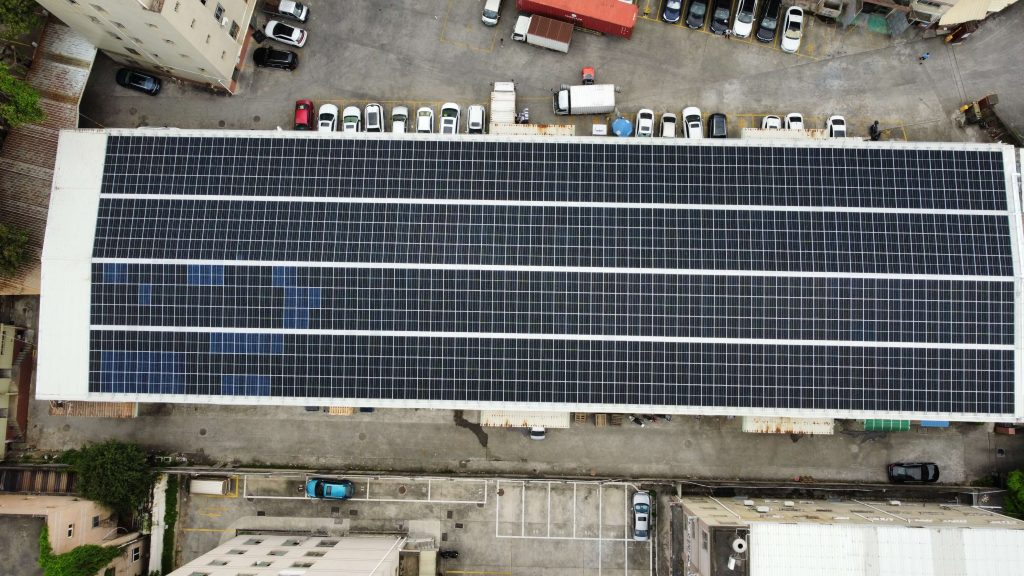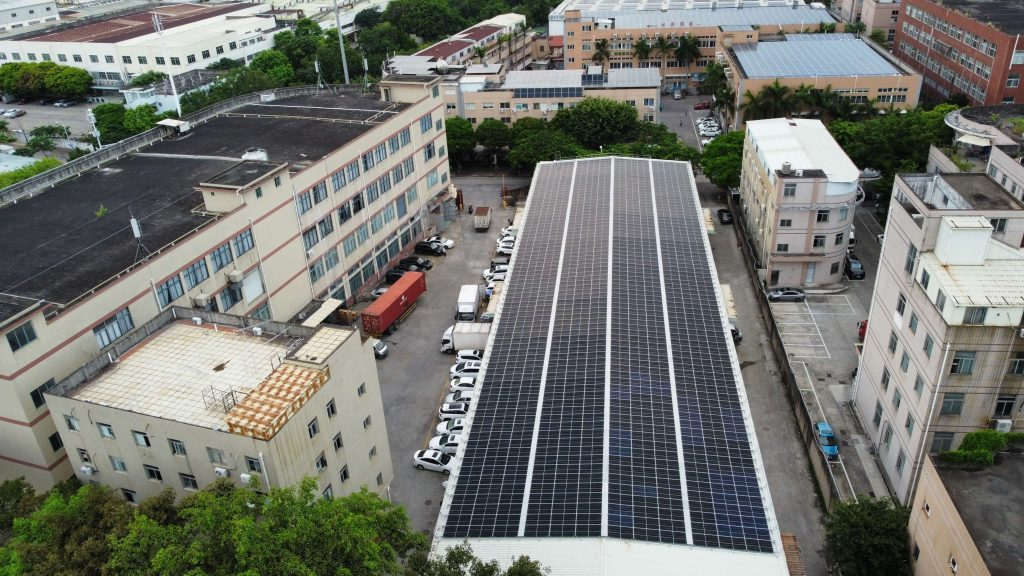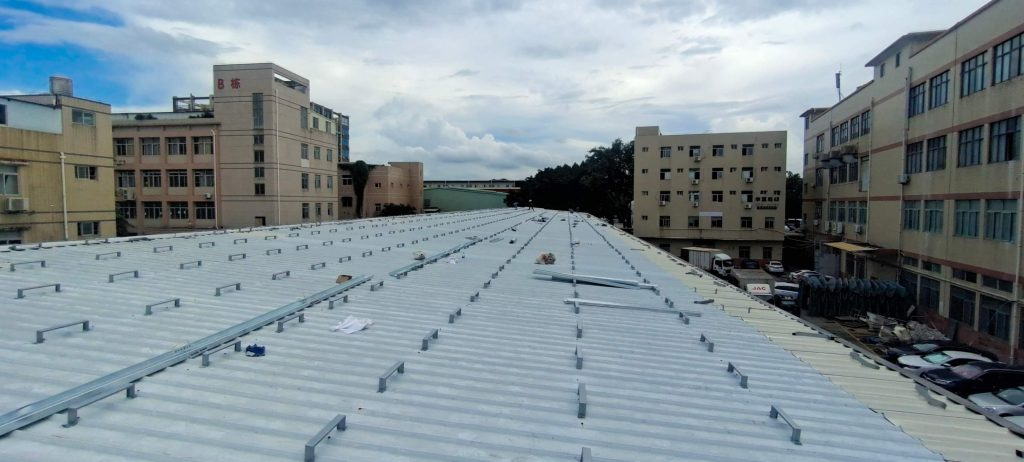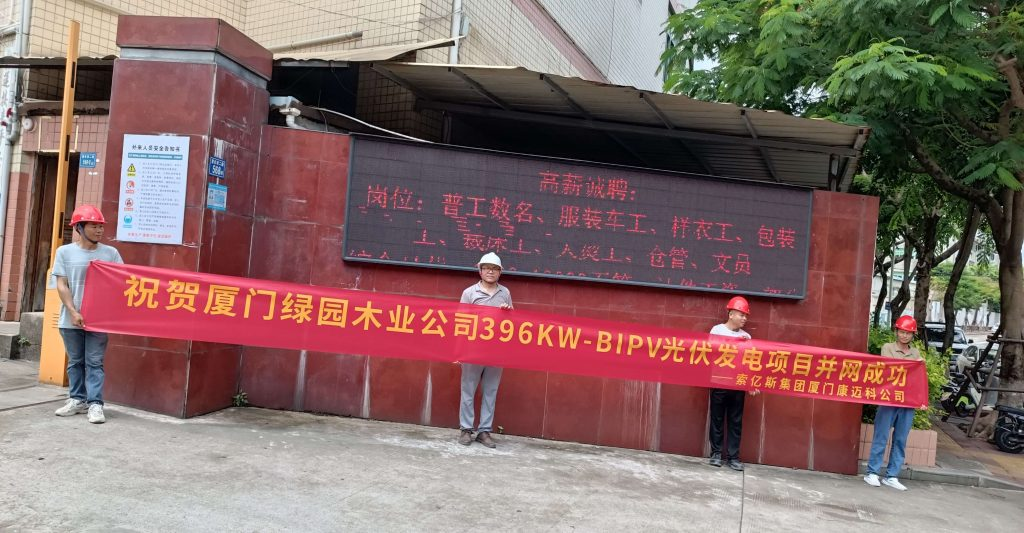



厦門興林グリーンガーデン木材産業会社 396KW
プロジェクトについて
本プロジェクトは、厦門杏林緑園木業有限公司による屋上太陽光発電所であり、「現地適応、クリーンで高効率、分散型配置、地産地消」の原則に基づき、「自家消費・余剰電力売電」のモデルで運用されます。屋上面積は約2197.69平方メートル、設置容量は396kWpで、出力440Wpの単結晶シリコン片面モジュールを900枚使用しています。本プロジェクトは、企業に経済的利益をもたらすだけでなく、社会にもポジティブな影響を与えます。主要設備には、太陽電池モジュール、インバーター、送電ケーブル、架台構造が含まれます。工期は約2ヶ月で、現地調査・設計、資材調達、施工、試運転、系統連系といった段階が含まれます。
気象条件の影響分析
温度条件
本プロジェクト地域の長年の極端最高気温は41.3℃、極端最低気温は-5.7℃です。夏の高温は部品の動作温度に対する要求を高めますが、冬の低温は発電効率の向上に寄与します。
雷の影響
当該地域の年間平均雷日数は65.3日で、雷の多い地域に属します。そのため、設備および建物の落雷対策が不可欠であり、安全な稼働を確保する必要があります。

設計上の要点
太陽光モジュールの選定
厦門の年間総日射量は4500〜5600 MJ/m²であり、結晶シリコンモジュールはアモルファスシリコンよりもコストおよび発電効率の点で優れています。屋根面積が限られているため、サイズが大きく、動作電圧とピーク出力の高い575Wpの単結晶シリコンモジュールを選定しました。
配列の設置方法
屋上スペースが分散しているため、固定型の架台を採用しました。設置方位角は建物の方向と一致させ、傾斜角も屋根構造に合わせることで、施工性と美観・排水性を両立させました。
インバーターの選定
各屋根の設置容量が異なるため、直流損失の低減と独立運用を考慮し、本プロジェクトでは複数容量のストリング型インバーター(最大出力100kW)を採用。インバーターとモジュールは1:1の比率で構成しています。
モジュール配列の設計
太陽光モジュールの方位角とは、太陽光の水平面への投影方向と真南との間の角度を指します。真南を基準(0°)として、西向きを正、東向きを負とします。本プロジェクトは赤道以北に位置するため、一般的にモジュールは真南を向けて設置することで最大限の発電効率が得られます。そのため、本プロジェクトでは各建物の屋根に設置する太陽光モジュールの方位角は、建物の方位に合わせて設計されています。
太陽光発電システムの設計において、モジュール配列の配置方法と傾斜角度は受け取る太陽放射量に大きな影響を与え、ひいては発電能力全体に影響します。したがって、最適な傾斜角を決定することは非常に重要な設計要素となります。気象局から提供される日射データは水平面における値であるため、実際の設置ではできるだけ多くの太陽エネルギーを得るために一定の傾斜角が必要となります。本プロジェクトの工場エリアはカラー鋼板屋根であり、屋根構造の制約を受けるため、モジュールの傾斜角は屋根の勾配と一致させ、屋根に沿った設置レイアウトを採用します。つまり、設置角度は屋根勾配と同一です。
また、本プロジェクトのカラー鋼板屋根には一部に影が生じる可能性があり、屋根上の設備やオフィス棟の影を避ける必要があります。回避の原則としては、冬至の日の午前9時から午後3時までの間にモジュールに影がかからないこととし、設置角度は屋根の傾きに沿って配置されます。
直列接続されるモジュール数の決定
参照気象観測所のデータによると、厦門エリアにおける極端な最高気温は41.3℃、極端な最低気温は-3.7℃です。設置場所およびシステム特性を考慮し、「太陽光発電所設計規範」(GB50797)の要件に基づいて計算した結果:
本プロジェクトでは、太陽光モジュールの直列接続方式として、1ストリングあたり15枚または17枚のモジュールを直列接続する設計となっています。

光伏支架的设计与安装
本プロジェクトの工場建物はすべて鉄骨構造であり、屋根はカラー鋼板屋根となっています。現場で使用されている太陽光架台はすべて、カラー鋼板屋根用のクランプ式太陽光架台です。太陽光モジュールは屋根の傾斜と同じ角度で設置されています。 設計においては、まず屋根の母屋(パーリン)に支持金具を固定し、その上に亜鉛アルミマグネシウム製の排水溝を取り付けます。太陽光モジュールはこの排水溝の上に配置され、クランプまたはネジでしっかりと固定されます。 この設置方式は建物本来の構造を損なうことなく、屋根の排水性能にも悪影響を与えず、雨漏りのリスクもありません。屋根の耐用年数を確保すると同時に、優れた防水性と断熱効果を兼ね備えています。
プロジェクトの成果とメリット
本プロジェクトの総設置容量は396kWpであり、年間フル稼働時間は約1450時間、年間平均発電量は約43.4万kWhと見込まれています。これは電力コストを削減し、オーナーに経済的利益をもたらすだけでなく、グリーンエネルギーの供給を通じて地域の持続可能な電力供給にも大きく貢献しています。
従来の石炭火力発電の代替として太陽光発電を活用することで、本プロジェクトは生態環境の保護に重要な役割を果たしています。年間で標準炭換算約154.8トンの石炭使用量を削減できるとされ、「三廃」の排出を効果的に抑制し、大気汚染の低減と空気品質の向上に寄与しています。
『2020年中国電力業界年次発展報告』によると、本プロジェクトにより年間で以下の汚染物質排出量が削減されると見込まれています:
- 粉じん排出量:約0.015トン削減
- 二酸化硫黄(SO₂)排出量:約0.008トン削減
- 窒素酸化物(NOₓ)排出量:約0.078トン削減
- 二酸化炭素(CO₂)排出量:約428.71トン削減
さらに、太陽光発電所の運転には水資源の消費がなく、火力発電に伴う排水(脱硫廃水や温排水)による水環境汚染も回避できます。
SOEASYの太陽光発電分野における専門的なソリューションについて詳しく知りたい方、または協業の可能性をお探しの方は、ぜひお気軽にお問い合わせください。世界中どこにいても、皆様とのご縁を心よりお待ちしております。太陽光発電がもたらす無限の可能性を共に切り開き、グリーンエネルギーの未来を築いていきましょう!
 English
English 




